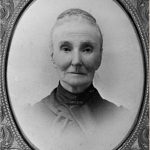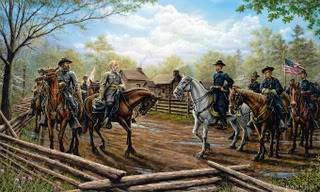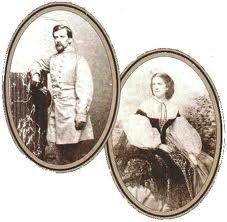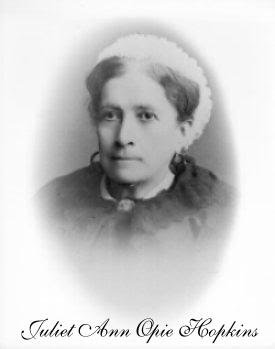Wife of Confederate General Joseph E. Johnston
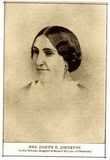 Lydia McLane was born January 31, 1822, at Wilmington, Delaware. She was the daughter of Catherine and Louis McLane. Her father was a diplomat and U.S. Cabinet officer, serving as U.S. Minister to England from 1829-1831, and from 1845-1846.
Lydia McLane was born January 31, 1822, at Wilmington, Delaware. She was the daughter of Catherine and Louis McLane. Her father was a diplomat and U.S. Cabinet officer, serving as U.S. Minister to England from 1829-1831, and from 1845-1846.
Joseph Eggleston Johnston was born February 3, 1807, at Longwood House in Farmville, Virginia, the eighth son of Judge Peter and Mary Johnston. He was named for the officer his father served under during in the Revolutionary War. When he was four years old, the family moved to Panicello, their new home near Abingdon, a location more convenient for Peter to serve the southwestern Virginia circuit.
Judge Johnston was an ardent huntsman, and his sons naturally followed his interest. A number of the veterans of the Battle of King’s Mountain lived in the area and excited the youthful interest of the boys by telling stories of their adventures. Emulating these heroes, the boys organized themselves into armies with young Joe as one of the leaders. With such a background of outdoor activity, he became a fine horseman and a good marksman.
On cold nights, the family gathered around the fireplace to listen to one of the older boys read. It was then that Joe first made his acquaintance with the novels of Sir Walter Scott, for which he retained an affection throughout his life. Mrs. Johnston gave him his earliest teaching, and he later attended the Abingdon Academy, which his father had helped to establish some years before.
Through a political friend, Judge Johnston secured Joe an appointment to West Point, which President John Quincy Adams made February 21, 1825, when Joe was eighteen years old. In the roster of cadets from Virginia was Robert E. Lee, the son of Judge Johnston’s Revolutionary leader.
In June of that year, the two young Virginians successfully passed the examinations to become members of an entering class of 105 cadets. Although Lee was slightly older, the two soon became fast friends. In the four years at West Point, Joe was associated with a number of cadets who later played important military roles in the Confederate Army. Three of them – Albert Sidney Johnston, Lee, and Joe Johnston – were among the first five nominations as full generals.
Johnston graduated from West Point in 1829. His class rank was 13th out of 46 and was commissioned in the Artillery. (Robert E. Lee was 2nd out of 46.) In addition to those who achieved military prominence in the Confederacy, a cadet from Mississippi in the class of 1828 became its president. During their period together at West Point, Johnston and Jefferson Davis were only casual acquaintances.
On July 10, 1845, Lydia McLane married Joseph Johnston. They had no children.
As an officer in the US Army, Johnston served in the Black Hawk war of 1832. He resigned his commission in 1837 to become a civil engineer in Florida, where served in the Seminole War in 1837. He was a member of General Winfield Scott’s expedition against Mexico City during the Mexican War, was made brevet colonel in 1848, and was wounded 5 times during that war. From 1855 – 1860, he served as Lieutenant Colonel in the 1st US Cavalry on the frontier and in Kansas during the border disturbances. On June 28, 1860, he was appointed quartermaster general of the US Army and promoted to Brigadier General.
When Virginia seceded from the Union in 1861, Johnston resigned as a brigadier general in the US Army, the highest-ranking US army officer to resign and join the Confederacy. He accepted a commission as a brigadier general in the Confederate Army, and was placed in command of the Army of Northern Virginia. His success as co-commander at the Battle of First Bull Run led to his promotion to the newly created rank of full general on August 31, 1861. But he wasn’t pleased that three other men outranked him.
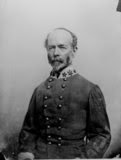
General Joseph E. Johnston
Confederate President Jefferson Davis had ranked Johnston fourth in seniority – behind Samuel Cooper, Albert Sidney Johnston, and Robert E. Lee. Johnston responded by writing Davis an angry letter. He claimed that the president’s rankings had been made “in violation of my rights as an officer, of the plighted [promised] faith of the Confederacy and the Constitution and laws of the land.” Johnston concluded by stating that “I now and here declare my claim that… I still rightfully hold the rank of first general in the armies of the Southern Confederacy.” But Davis refused to reconsider; he sent Johnston an insulting reply in which he called the general’s arguments and statements “one-sided” and “as unfounded as they are unbecoming.”
Still, Johnston led the Southern army at the 1862 Peninsula Campaign. Defending the capital of Richmond against General George B. McClellan, Johnston employed a strategy of gradual withdrawals, until his army was only five miles in front of the city. Finally cornered, Johnston attacked on May 31,1862, at the Battle of Seven Pines. The battle was tactically inconclusive, but it stopped McClellan’s advance on Richmond.
Johnston was severely wounded on the second day of the battle, and Davis turned over command to the more aggressive General Robert E. Lee. Johnston spent the remaining days of 1862 recovering from the wounds he suffered at Fair Oaks.
One month later, Lee forced McClellan to end his offensive campaign by defeating the Union general in a series of fierce clashes that came to be known as the Seven Days’ Battles. Lee then followed up that victory with a series of other triumphs. Lee’s performance convinced Davis to give him command of the Army of Northern Virginia for the rest of the war.
After recovering from his wound, Johnston was given command of the Department of the West, which gave him control of Braxton Bragg’s Army of Tennessee and John C. Pemberton’s Department of Mississippi and East Louisiana. Pemberton faced General Ulysses S. Grant from inside the besieged city of Vicksburg, Mississippi, and Johnston was not able to find troops to relieve him, causing great consternation in the South when its last stronghold on the Mississippi River.
Johnston, Davis, and other Confederate officials continued to argue and debate about strategy, military authority, and other issues throughout the first few months of 1863. Meanwhile Union General Ulysses S. Grant launched a major offensive against Vicksburg, Mississippi, an important Confederate stronghold. If Grant could seize the city from the Confederacy, the North would control the entire length of the Mississippi River.
The struggle for Vicksburg ended in disaster for the Confederacy. In late May, Grant ordered his army to surround the city and stop all shipments of food and other supplies. Within a matter of weeks, Grant’s siege had created great hunger and misery within Vicksburg. Johnston tried to come up with a plan to lift the siege, but the small size of his army prevented him from posing any significant threat to Grant’s much larger force. Pemberton finally surrendered on July 4, 1863, giving the North control of both the city and the Mississippi River.
When President Jefferson Davis learned that Vicksburg had fallen into Union hands, he blamed Johnston. He and many other people believed that Johnston should have offered more resistance to Grant. They charged that Johnston had been too cautious and timid in his actions. Johnston and his supporters, meanwhile, blamed flawed strategies devised by Davis and other Confederate officials for the loss of the city.
Later that year, General Braxton Bragg was defeated in the Battle of Chattanooga, and Jefferson reluctantly relieved his old friend of command and replaced him with Johnston as commander of theArmy of Tennessee, a tough and battle-hardened force. But over the past year, it had been badly led by General Bragg.
In May 1864, Johnston faced his first major test as commander of the Army of Tennessee. A Union army of 100,000 under the command of General William Tecumseh Sherman had marched into Georgia to destroy Johnston’s army of 60,000. The North believed that if that army could be wiped out, Union control of the West would be complete, and weakening Southern support for the war might collapse altogether.
Throughout the months of May and June, Sherman moved his army southward in an attempt to smash the Confederate Army of Tennessee. The two armies engaged in countless bloody skirmishes during this period, but Johnston quickly and skillfully avoided all efforts to trap him. Instead, he steadily retreated deeper into Georgia, even as President Davis and other Confederate officials urged him to turn and attack the Yankee invaders.
By mid-July, Sherman had seized large sections of Georgia. Johnston’s army had been pushed backward to the outskirts of Atlanta, one of the Confederacy’s last remaining major cities. Johnston’s defensive maneuvers had enabled him to keep most of his army intact, but Davis and many other Confederate officials were very unhappy with his performance. They openly worried that Johnston might give up Atlanta without a fight, and became very frustrated when the general stubbornly refused to tell them about his plans.
Jefferson Davis became increasingly irritated and relieved Johnston of command on July 17, 1864, shortly before the Battle of Peachtree Creek, and replaced him with General John Bell Hood, an officer who had a reputation as a fierce and aggressive fighter. Within a few months, Sherman had captured Atlanta and launched a devastating campaign deep into the heart of the South. Hood, meanwhile, took his army into Tennessee, where it was torn to shreds by Union forces.
Johnston spent the last part of 1864 traveling around the South with Lydia. In February 1865, General Lee convinced Davis to recall Johnston to active service in the disintegrating Confederate Army. Johnston was ordered to assume command of rebel troops in the Carolinas and halt Sherman’s advance on Richmond, but no Southern army was capable of stopping the Union forces as they rolled across the Confederacy.
From February to April 1865 Johnston led the remnants of the Army of Tennessee to North Carolina, where he successfully blocked his old antagonist Sherman from combining forces with Grant against Lee. On March 19, 1865, Johnston caught a portion of Sherman’s army by surprise at the Battle of Bentonville, and briefly gained some tactical successes before superior numbers forced him to retreat.
But after learning of Lee’s surrender at Appomattox Court House – despite orders to the contrary from Jefferson Davis – Johnston surrendered his army to General Sherman at the Bennett Place near Durham, North Carolina, on April 26, 1865.
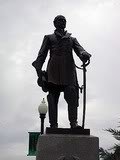
General Johnston Statue
The only statue of General Johnston
Dalton, Georgia
After the war, Johnston engaged in various pursuits. He was president of a railroad company in Arkansas, and became engaged in the insurance business in 1868 and 1869. He wrote an analysis of his activities in the Civil War, Narrative of Military Operations, published in 1874, in which he was highly critical of President Jefferson Davis and many of his fellow generals.
He returned to Virginia and settled in Richmond in 1877, and became president of an express company. Johnston served in the 46th Congress from 1879 to 1881 as a Democratic Congressman from Virginia, and was appointed Commissioner of Railroads by President Grover Cleveland in 1887 and served until 1891.
Lydia McLane Johnston died February 22, 1887, in Washington, DC, and was buried in Green Mount Cemetery in Baltimore, Maryland.
Like Robert E. Lee, Johnston never forgot the man he surrendered to at the end of the Civil War, and would not allow an unkind word to be said about General Sherman – once his adversary, now his friend – in his presence.
When Sherman died, Johnston was a pallbearer at his funeral; during the procession in New York City on February 19, 1891, he kept his hat off as a sign of respect, though it was a cold winter day. Someone asked him to put on his hat, to which Johnston replied, “If I were in his place and he standing here in mine, he would not put on his hat.” He had done the same for Generals Ulysses S. Grant and Philip Sheridan. Johnston contracted pneumonia after the funeral, and his strength gradually failed.
General Joseph E. Johnston died of a heart attack on March 21, 1891, in Washington DC, at the age of 84. He was the last of the great leaders of the Civil War, both Federal and Confederate, with the exception of Beauregard. He was buried beside his wife in Green Mount Cemetery in Baltimore.
SOURCES
Joseph E. Johnston
Maryland Historical Society
Joseph Eggleston Johnston
General Joseph E. Johnston
Wikipedia: Joseph E. Johnston
Biography of Joseph E. Johnston
Boyhood Home of General Joseph E. Johnston
Confederate General Joseph Eggleston Johnston
